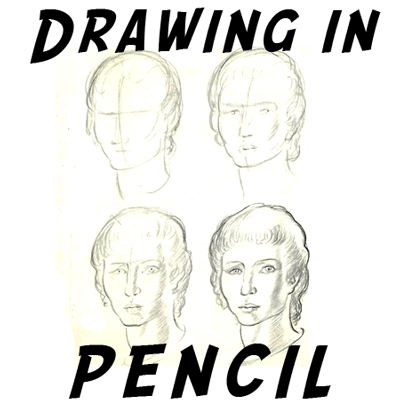Pencil Drawing : How to Draw with Pencils Lesson
If you want to do a finished drawing with a pencil, the first thing to do is to get the right pencil for you and the work you want it to do. Ordinary lead pencils usually have number markings that show how hard or soft they are. No. i is a very soft pencil, No. 2 is medium, No. 3 is hard, and No. 4 is very hard. There are some pencils that have 1/2 markings on them. I like to use pencils marked 21/2. The lines made by softer pencils are apt to smudge as you work, and a harder pencil makes too light a line to suit me. I also like to draw sometimes with an Eagle Veri-thin Black 747 pencil. It gives a good dark line, but it is a little harder to erase than one of the ordinary No. 21/2 pencils. When I draw, I usually like to be able to erase.
You will also want a “kneading rubber” — a very soft, pliable rubber — and some heavy bond typewriting paper. That paper has just enough “tooth” or graininess to its surface to catch your pencil strokes well. Everyone uses a pencil easily and carelessly for writing, doodling, playing tick-tack-toe, etc. But when a beginner starts to draw he usually grips his pencil too tightly. Then he either digs the point into his paper or timidly draws a wavering line as though he were afraid of it. A pencil will do anything for you provided you don’t choke it to death with your fingers!

Hold your pencil just enough to guide it, gently but firmly. Begin by scribbling a little with your wrist resting lightly on your board and your hand holding your pencil lightly. Draw loosely, easily, some rhythmic lines on your paper. Just doodle a bit. Try holding your pencil in different positions in your hand until it works nicely.

Now begin to draw!
Start by lightly whirling in the shape you want to draw. Don’t worry about your lines. You have that good kneading eraser in your other fist. Remember that one of the beauties of good drawing is the rhythm and flow of the lines. When you have some pretty good shapes whirled in, draw your definite surrounding outline.
SHADING (OR MODELING) YOUR DRAWING
The eye of a camera can see and reproduce only the lights and shadows that fall on an object. But an artist can see and choose those special lights and shadows on an object which will help give his drawing depth and volume. And drawing those lights and shadows is a process that is usually called “shading.”
I prefer to call it modeling. To model means to give something form or shape and that is exactly what shading should do. Shading should help give shapes a third dimension. You can, with a little shading, bring forms forward or push them back in your drawing. You can give them a soft round look, or make them look hard and sharp.


The light which falls on the object you are drawing usually comes from only one side and makes shadows on the other side. But there are also many reflecting lights that affect the object you are trying to draw. Do not let any of the natural lights influence your drawing too much. Use light and shadow for your own purposes. You really draw with light as well as with line and shade on your paper. Remember this along with the fact that you are using shading only to give your drawing depth and volume. Then you will not make the mistake of shading your drawing so much that it looks crude and dirty. To develop the tone or shade around your drawing you can crosshatch. Hold your pencil lightly, remember.


When you put down the final lines surrounding your shapes, use a light line on the side nearest the source of light that falls on the object you are drawing. The outline on the darker side of the object can be drawn with a darker, heavier line. But neither outline should be all dark or all light. The lines should go lightly, then darken to model the forms. Sometimes it is wise to use the darker outline on the lighter side of the object, and the light line on the darker side. If you want to keep your pencil drawing, use a fixative to fix it to your paper or it will become smudged and rub off. Fixative is a liquid with an alcohol base combined with some sticky substance, perhaps shellac or gum arabic. You blow a thin mist of it through a tube onto your drawing. When the fixative dries your drawing should stay on the paper. Bottles of fixative and small metal tubes used for blowing it are sold in all art supply shops. They are not expensive.
In drawing lines to shade a form, it is usually best to draw with the movement of the form. But there are times when you can get a better effect by drawing against the movement. Try both methods. You still have that good kneading rubber in your other hand and you can change your drawing.


Pencil drawing by Edgar Degas (1834-1917)
QUALITIES OF PENCIL DRAWING
Each different material with which you draw has its own special quality. Pencil lines can be harsh, or strong, or beautiful and flowing. They can be almost tender. Here are some qualities you should try for in pencil drawing:
- three-dimensional shape
- good movement
- delicate tones
- fine, rhythmic, almost poetic lines.

Pencil drawing by Jean Auguste Ingres (1780-1867)

thank you now i can improve my drawing very well
thanks for this helpful webpage it is realy great
It’s really great. I can draw really good now!!:)
That makes it all worth while. Keep practicing!
superbbbbbbbbbbbbb website. pencil drawings are highlite of this website . it insipers.